First stage of herpes on lips. Cold Sore Stages: From Tingling to Healing – A Comprehensive Guide
What are the five stages of cold sores. How long do cold sores typically last. What are the best treatments for cold sores at different stages. How can you prevent cold sores from recurring. What triggers cold sore outbreaks.
Understanding Cold Sores: Causes and Transmission
Cold sores, medically known as herpes labialis, are a common viral infection caused by the nongenital herpes simplex virus type 1 (HSV-1). These painful blisters typically appear on or around the lips, although they can also develop inside the mouth. Understanding the causes and transmission of cold sores is crucial for effective prevention and management.
HSV-1 is primarily transmitted during childhood through nonsexual contact. However, adults can also contract the virus through sexual activity. Once infected, the virus remains dormant in skin cells and neurons beneath the skin until triggered.
Common Triggers for Cold Sore Outbreaks
- Stress
- Fever
- Sun exposure
- Extreme temperatures
- Ultraviolet radiation
- Compromised immune system
- Physical injury to the affected area
These factors can awaken the hibernating virus, leading to a cold sore outbreak. Recognizing these triggers can help individuals take preventive measures and initiate early treatment.

The Five Stages of Cold Sore Development
Cold sores typically progress through five distinct stages, with the entire cycle lasting between 9 and 12 days. Understanding these stages can help in early detection and prompt treatment, potentially reducing the duration and severity of the outbreak.
Stage 1: Prodrome (Day 1-2)
The first stage of a cold sore is characterized by a tingling, itching, or burning sensation beneath the skin around the mouth or base of the nose. This prodrome stage is crucial for early intervention.
Additional symptoms during this stage may include:
- Malaise
- Fever
- Tender or swollen lymph nodes
While no visible blister is present at this stage, initiating treatment can potentially prevent or minimize the cold sore’s development.
Stage 2: Blister Formation (Day 2-3)
If left untreated, a fluid-filled blister typically develops within 1 to 2 days after the initial symptoms. This marks the beginning of the visible cold sore.
Stage 3: Ulcer or Weeping Stage (Day 4)
Around the fourth day, the blister opens up and releases its fluid. This stage is often the most painful and contagious. Direct contact with the fluid can lead to transmission of the virus.

Stage 4: Crusting (Day 5-8)
Between days 5 and 8, the cold sore begins to dry up, forming a yellow or brown crust. This crust may crack or break, requiring careful attention to prevent further complications or delayed healing.
Stage 5: Healing (Day 9-12)
In the final stage, several scabs may form and flake off. Each new scab is typically smaller than the previous one until the wound heals completely. In most cases, cold sores do not leave a scar.
Treatment Options for Cold Sores
Effective treatment of cold sores often involves a combination of oral and topical medications. The key to successful management is early intervention, ideally at the first sign of symptoms.
Oral Medications
Commonly prescribed oral medications for cold sores include:
- Acyclovir (Zovirax)
- Famciclovir (Famvir)
- Valacyclovir (Valtrex)
These antiviral drugs work by inhibiting the replication of the herpes simplex virus, potentially shortening the duration of the outbreak and reducing symptom severity.
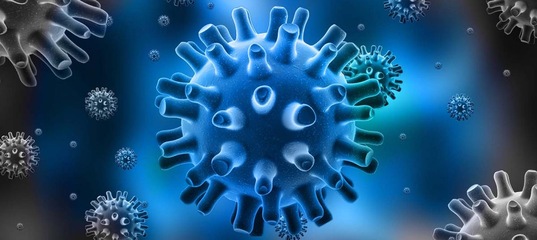
Topical Treatments
Topical treatments can be applied directly to the affected area and include:
- Acyclovir (Zovirax) cream
- Docosanol (Abreva)
- Penciclovir (Denavir) cream
These treatments can help alleviate symptoms and may speed up the healing process when used in conjunction with oral medications.
The Importance of Early Treatment
Initiating treatment at the first sign of symptoms, particularly during the prodrome stage, can significantly impact the course of a cold sore outbreak. Early intervention may prevent the cold sore from fully developing or reduce its duration and severity.
A study published in Antimicrobial Agents and Chemotherapy found that high doses and short courses of valacyclovir could reduce the duration of a cold sore by approximately one day. While this may seem modest, it can make a significant difference in terms of discomfort and the risk of transmission.
Preventing Cold Sore Transmission
Cold sores are highly contagious, particularly during the ulcer or weeping stage. Understanding how the virus spreads is crucial for preventing transmission.

How Cold Sores Spread
Transmission typically occurs through direct contact with the fluid from an open blister. This can happen through:
- Kissing
- Sharing utensils or drinkware
- Using shared cosmetics
- Sharing towels or other personal items
The incubation period for cold sores ranges from 2 to 20 days after contact with an infected person. During this time, an individual may be asymptomatic but still capable of spreading the virus.
Precautions to Prevent Transmission
- Avoid physical contact with others during an active outbreak
- Refrain from sharing personal items
- Wash hands frequently, especially after touching the affected area
- Apply medication using disposable cotton swabs to avoid contaminating the product
- Replace toothbrushes and other items that may have come into contact with the cold sore
Managing Recurring Cold Sores
For individuals who experience frequent cold sore outbreaks, preventive measures and long-term management strategies are essential. Chronic cold sores can significantly impact quality of life and may require ongoing treatment.

Preventive Treatments
Daily antiviral medications can help prevent recurrent outbreaks. The American Academy of Pediatrics recommends the following preventive dosages:
- Acyclovir: 400 mg, twice daily
- Valacyclovir: 500 mg, once daily
These medications must be taken regularly to maintain their preventive effect. Consult with a healthcare provider to determine the most appropriate preventive treatment plan.
Lifestyle Modifications
In addition to medication, certain lifestyle changes can help reduce the frequency and severity of cold sore outbreaks:
- Consume foods high in lysine, such as red meats, fish, and dairy products
- Apply sunscreen to the face and lips before sun exposure
- Manage stress through relaxation techniques or exercise
- Maintain a healthy immune system through proper nutrition and adequate sleep
- Avoid known triggers when possible
The Role of Nutrition in Cold Sore Management
While medication plays a crucial role in treating and preventing cold sores, nutrition can also contribute to managing outbreaks and supporting overall immune function. Certain nutrients have been associated with reduced frequency and severity of cold sore outbreaks.

Lysine-Rich Foods
Lysine is an essential amino acid that may help prevent HSV-1 replication. Foods high in lysine include:
- Beef and lamb
- Poultry
- Fish, particularly salmon and tuna
- Dairy products like cheese and yogurt
- Eggs
- Soybeans and tofu
Incorporating these foods into your diet may help reduce the frequency of cold sore outbreaks.
Foods to Limit
Conversely, some foods are high in arginine, an amino acid that may promote HSV-1 replication. While it’s not necessary to completely avoid these foods, limiting their consumption during an outbreak may be beneficial:
- Nuts and seeds
- Chocolate
- Whole grains
- Gelatin
Immune-Boosting Nutrients
Supporting overall immune function can help your body fight off cold sore outbreaks. Focus on consuming foods rich in:
- Vitamin C (citrus fruits, berries, leafy greens)
- Vitamin E (nuts, seeds, vegetable oils)
- Zinc (oysters, beef, pumpkin seeds)
- Selenium (Brazil nuts, seafood, whole grains)
The Psychological Impact of Cold Sores
While cold sores are primarily a physical condition, they can have significant psychological and social impacts on those who experience them. Understanding and addressing these aspects is crucial for comprehensive cold sore management.
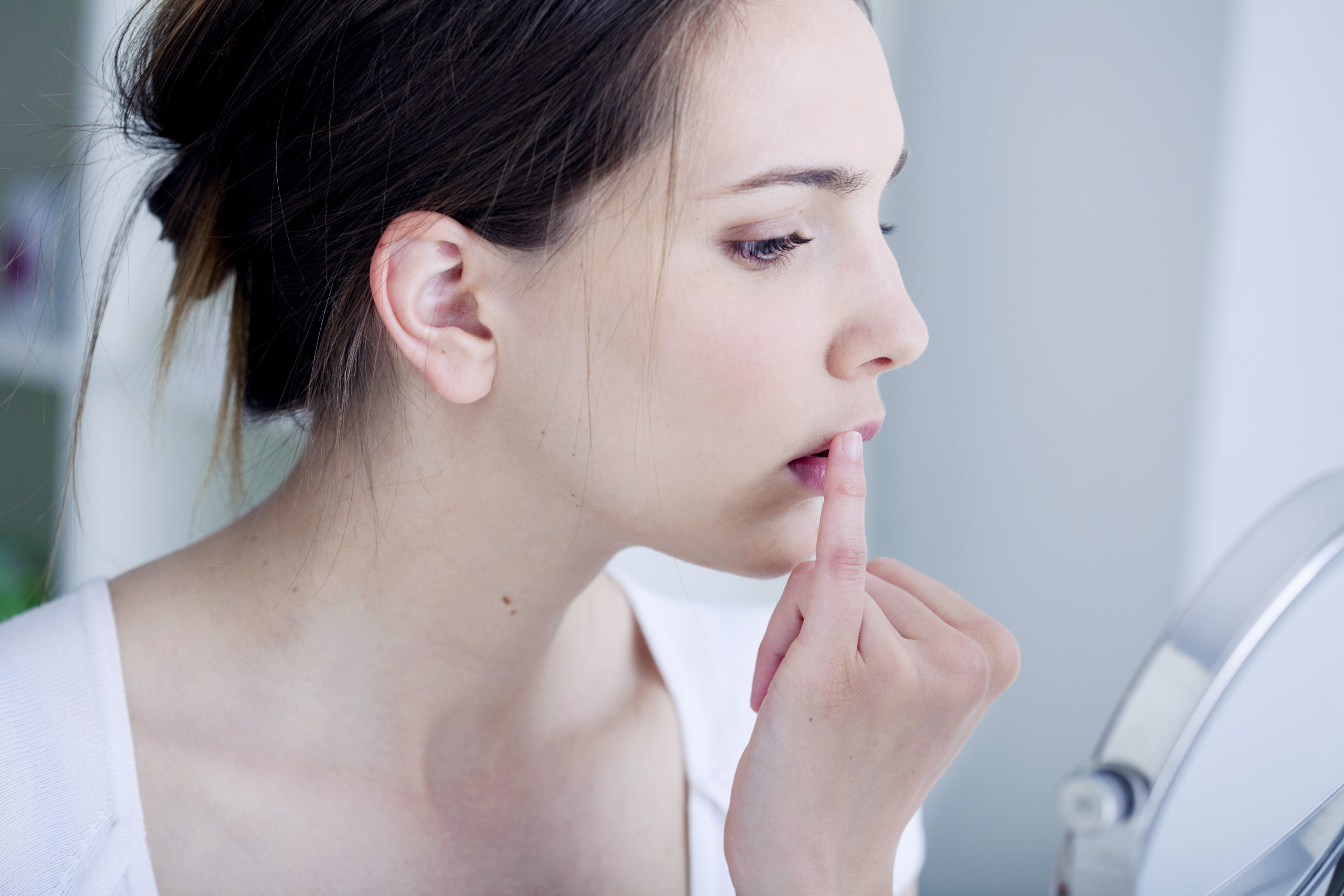
Emotional Challenges
Individuals with recurrent cold sores may experience:
- Embarrassment or self-consciousness
- Anxiety about potential outbreaks
- Depression, especially during active outbreaks
- Social withdrawal
- Reduced self-esteem
Coping Strategies
To address the psychological impact of cold sores, consider the following strategies:
- Educate yourself and others about cold sores to reduce stigma
- Practice stress-reduction techniques to manage anxiety about outbreaks
- Seek support from friends, family, or support groups
- Consider counseling if cold sores significantly impact your mental health
- Focus on overall health and well-being to boost confidence
Emerging Research and Future Treatments
As our understanding of the herpes simplex virus evolves, researchers continue to explore new treatment options and potential cures for cold sores. While current treatments focus on managing symptoms and reducing outbreak frequency, future therapies may offer more comprehensive solutions.
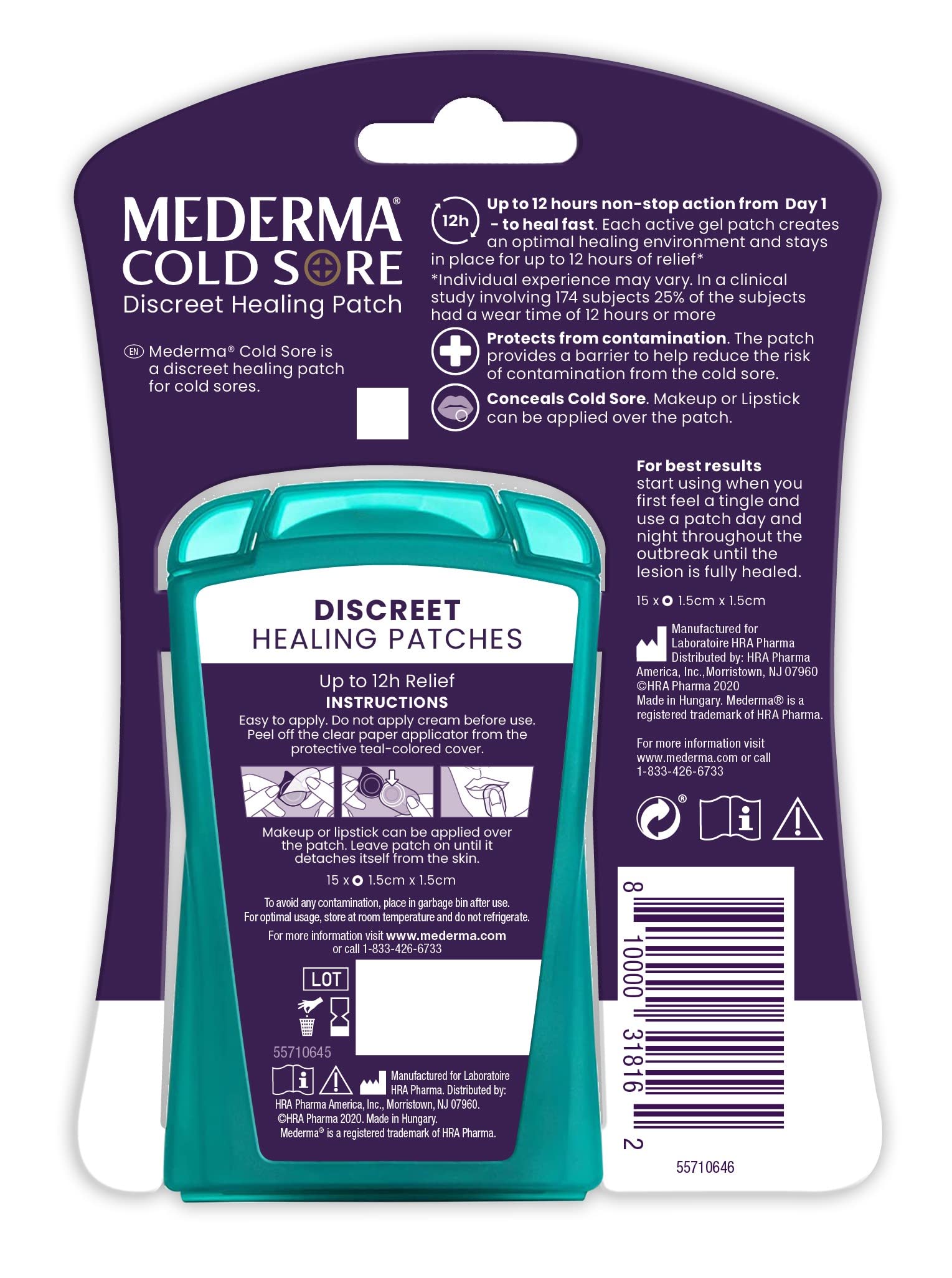
Gene Editing Techniques
Recent studies have investigated the use of CRISPR gene editing technology to target and eliminate the HSV-1 virus from infected cells. While still in early stages, this approach shows promise for potentially eradicating the virus from the body.
Immunotherapy
Researchers are exploring ways to enhance the body’s immune response to the herpes simplex virus. This could lead to more effective treatments and possibly prevent the virus from establishing latency in nerve cells.
Novel Antiviral Compounds
Scientists continue to search for new antiviral compounds that could more effectively inhibit viral replication or prevent the virus from entering cells. These efforts may result in more potent treatments with fewer side effects.
Therapeutic Vaccines
While a preventive vaccine for HSV-1 remains elusive, researchers are working on therapeutic vaccines that could help those already infected manage their condition more effectively. These vaccines aim to boost the immune system’s ability to control the virus and reduce outbreak frequency.
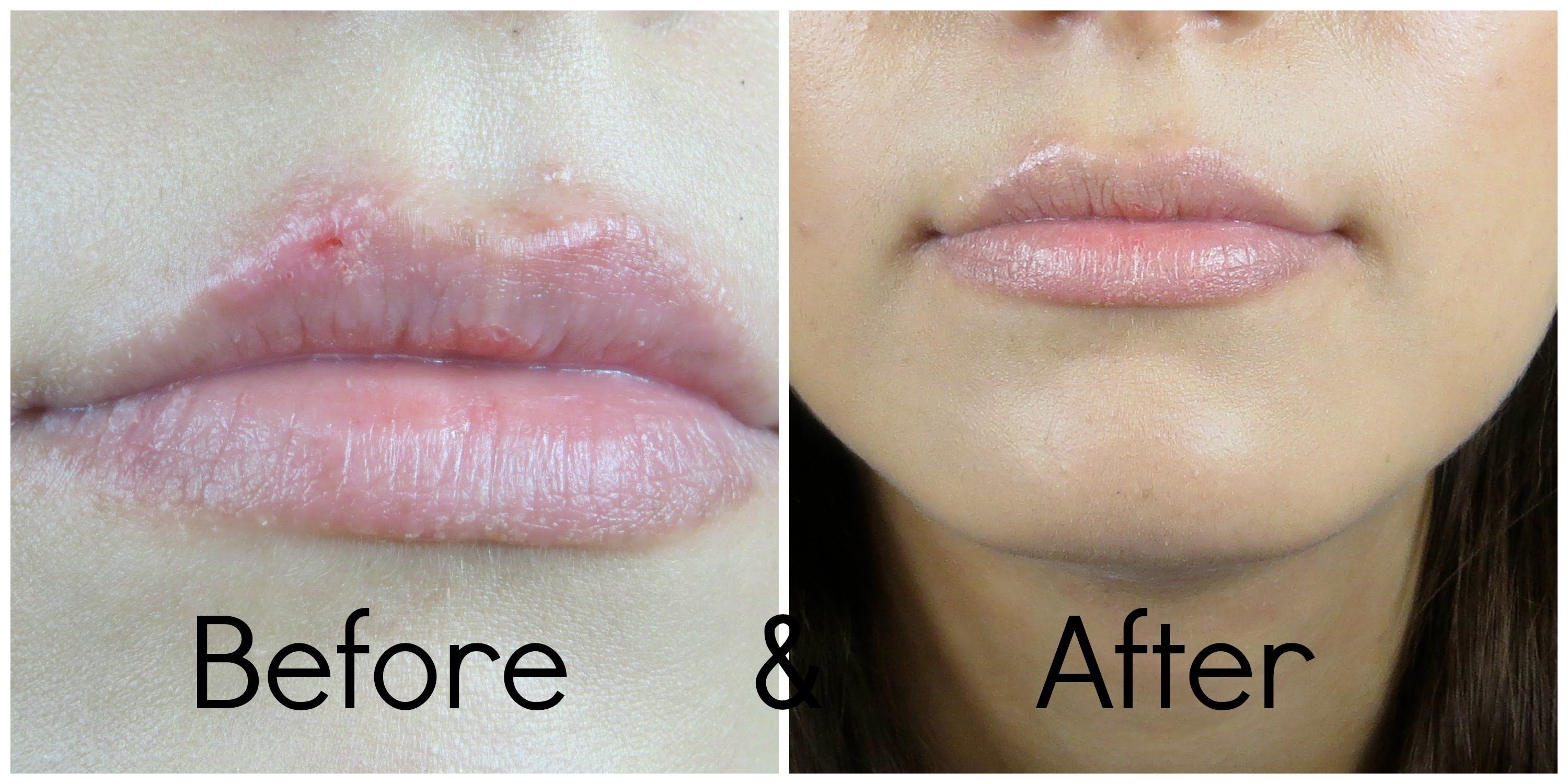
As research progresses, individuals affected by cold sores can look forward to potentially more effective treatment options in the future. In the meantime, early intervention, consistent management, and a holistic approach to health remain the best strategies for dealing with cold sores.
Cold sore stages: Pictures, duration, and treatment
There are five stages of cold sores. These lead from the initial tingling in the area to the healing stage.
Cold sores, also known as herpes labialis, are caused by nongenital herpes simplex virus type 1. People can develop a cold sore on their lips or in their mouth.
Transmission of the nongenital herpes simplex virus type 1 (HSV-1) occurs during childhood through nonsexual contact, but adults can contract the infection through sexual activity. HSV-1 hibernates inside skin cells and neurons under the skin until a trigger stimulates it.
Before the cold sore appears, people may feel a burning, stinging, or itching sensation on their lips. For best results, doctors recommend starting treatment as soon as the tingling begins, before the cold sore appears.
In this article, we discuss the stages of a cold sore and what to do if a cold sore develops. We also explore how doctors treat the infection and how people can avoid getting a cold sore.
A cold sore develops in five stages and will typically last between 9 and 12 days.
Stage 1
Initially, people will feel a tingling, itching, or burning sensation underneath the skin around the mouth or base of the nose. Doctors call this the prodrome stage.
Other symptoms that may occur during this stage include:
- malaise
- fever
- tender or swollen lymph nodes
At this first stage of the cold sore, people will not see a blister. People with recurring cold sores may present milder symptoms. Doctors recommend starting treatment as soon as these symptoms begin.
Treatment for cold sores may include oral or topical medications. Sometimes people will use both types to treat a cold sore.
Oral medications for cold sores include:
- acyclovir (Zovirax)
- famciclovir (Famvir)
- valacyclovir (Valtrex)
Topical treatments for cold sores include:
- acyclovir (Zovirax) cream
- docosanol (Abreva)
- penciclovir (Denavir) cream
Treatment aims to shorten the duration of the cold sore. In one study published in Antimicrobial Agents and Chemotherapy, researchers found that high doses and short courses of valacyclovir may reduce the duration of a cold sore by about 1 day.
In one study published in Antimicrobial Agents and Chemotherapy, researchers found that high doses and short courses of valacyclovir may reduce the duration of a cold sore by about 1 day.
Taking medication when symptoms first appear can prevent or block the cold sore from appearing.
Stage 2
If the person does not use any medication, a fluid-filled blister will likely develop around 1 to 2 days after the initial symptoms.
Stage 3
The third stage, which occurs around day 4, involves the blister opening up and releasing its fluid. Doctors call this stage the ulcer or weeping stage. If another person comes into contact with the blister’s fluid, they may develop a cold sore as well.
Cold sores are contagious and tend to be painful during this stage.
Stage 4
Between days 5 and 8, the cold sore will dry up, leaving a yellow or brown crust. The crust will eventually flake off.
People must take care of the scab during this stage because it can crack or break.
Stage 5
The final stage of a cold sore is the healing stage.
Several scabs may form and flake off during this stage. Every new scab will be smaller and smaller until the wound heals completely. Most often, the cold sore will not leave a scar.
Some doctors suggest that a cold sore can last around 2 to 6 weeks.
People who come into contact with another person’s cold sore may be at risk of infection. However, they would have to come into contact with the fluid when the blister ruptures.
Some people may develop recurring cold sores. According to the American Family Physician (AAP), various stimuli can awaken the hibernating virus, such as:
- stress
- fever
- sun exposure
- extremes in temperature
- ultraviolet radiation
- a compromised immune system
- injury
When a cold sore enters the ulcer or weeping stage, around the fourth day, the cold sore becomes contagious.
People who come into contact with the fluid from another person’s open blister can develop a cold sore between 2 to 20 days after contact.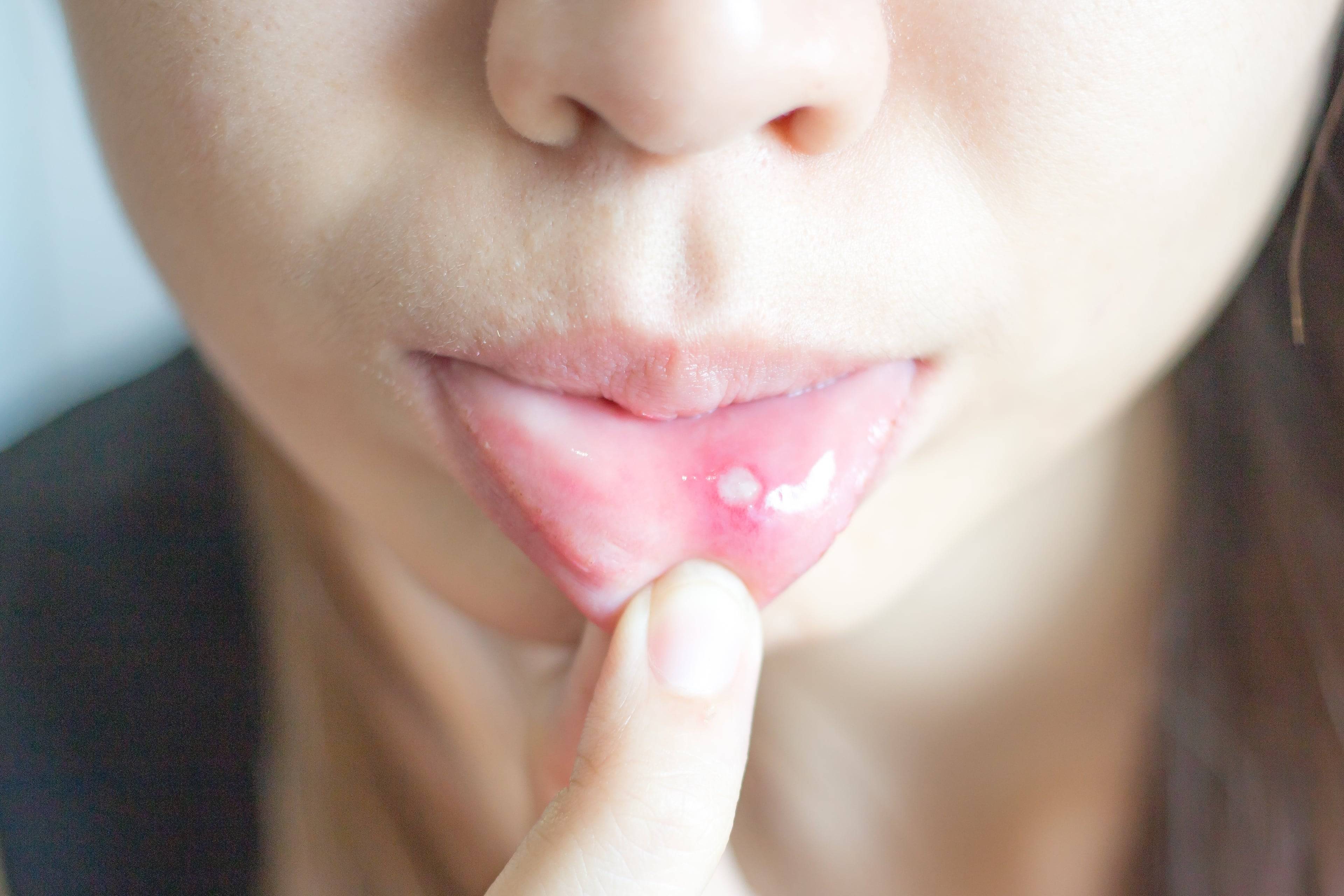
People can come into contact with fluid from another person’s cold sore through kissing or sharing utensils, drinkware, cosmetics, or towels.
Doctors suggest that treating a cold sore at the start of symptoms, before the blister appears, may prevent the cold sore from appearing.
People with a history of cold sores can usually detect the initial symptoms and know they need to start treatment right away.
Some people get chronic cold sores and may require preventive treatments. Taking acyclovir or valacyclovir every day may prevent cold sores.
According to the AAP, the recommended doses for each drug are:
- acyclovir 400 milligrams (mg), twice daily
- valacyclovir 500 mg, once daily
People with chronic cold sores will need to take preventive treatments regularly. Also, doctors and dentists recommend:
- eating foods high in lysine, such as red meats, fish, and dairy
- applying sunscreen to the face and lips before going outside throughout the year
- shaving with a disposable razor blade when a cold sore appears
- replacing toothbrushes
- avoiding stress
People should avoid intimate contact with people who have cold sores. Avoid sharing utensils, toothbrushes, towels, and razors.
Avoid sharing utensils, toothbrushes, towels, and razors.
People with cold sores should avoid touching the blister, and if they do, they need to wash their hands thoroughly.
Cold sores are a common infection of nongenital HSV-1 that people can contract through sexual and nonsexual activities.
People who start treatment when they feel tingling and itching around their lips may block the cold sore from appearing.
If a cold sore appears, it will go through five stages from the prodrome stage to healing. During the ulcer stage, people can transmit the virus to another person. The fluid in the blister contains the virus. People with cold sores must avoid kissing and sharing utensils, towels, and drinkware.
A person may have a cold sore for about 2 weeks, but some doctors suggest that a cold sore can last up to 6 weeks. Medications can help shorten the duration of a cold sore.
Cold sore stages: Pictures, duration, and treatment
There are five stages of cold sores. These lead from the initial tingling in the area to the healing stage.
These lead from the initial tingling in the area to the healing stage.
Cold sores, also known as herpes labialis, are caused by nongenital herpes simplex virus type 1. People can develop a cold sore on their lips or in their mouth.
Transmission of the nongenital herpes simplex virus type 1 (HSV-1) occurs during childhood through nonsexual contact, but adults can contract the infection through sexual activity. HSV-1 hibernates inside skin cells and neurons under the skin until a trigger stimulates it.
Before the cold sore appears, people may feel a burning, stinging, or itching sensation on their lips. For best results, doctors recommend starting treatment as soon as the tingling begins, before the cold sore appears.
In this article, we discuss the stages of a cold sore and what to do if a cold sore develops. We also explore how doctors treat the infection and how people can avoid getting a cold sore.
A cold sore develops in five stages and will typically last between 9 and 12 days.
Stage 1
Initially, people will feel a tingling, itching, or burning sensation underneath the skin around the mouth or base of the nose. Doctors call this the prodrome stage.
Other symptoms that may occur during this stage include:
- malaise
- fever
- tender or swollen lymph nodes
At this first stage of the cold sore, people will not see a blister. People with recurring cold sores may present milder symptoms. Doctors recommend starting treatment as soon as these symptoms begin.
Treatment for cold sores may include oral or topical medications. Sometimes people will use both types to treat a cold sore.
Oral medications for cold sores include:
- acyclovir (Zovirax)
- famciclovir (Famvir)
- valacyclovir (Valtrex)
Topical treatments for cold sores include:
- acyclovir (Zovirax) cream
- docosanol (Abreva)
- penciclovir (Denavir) cream
Treatment aims to shorten the duration of the cold sore.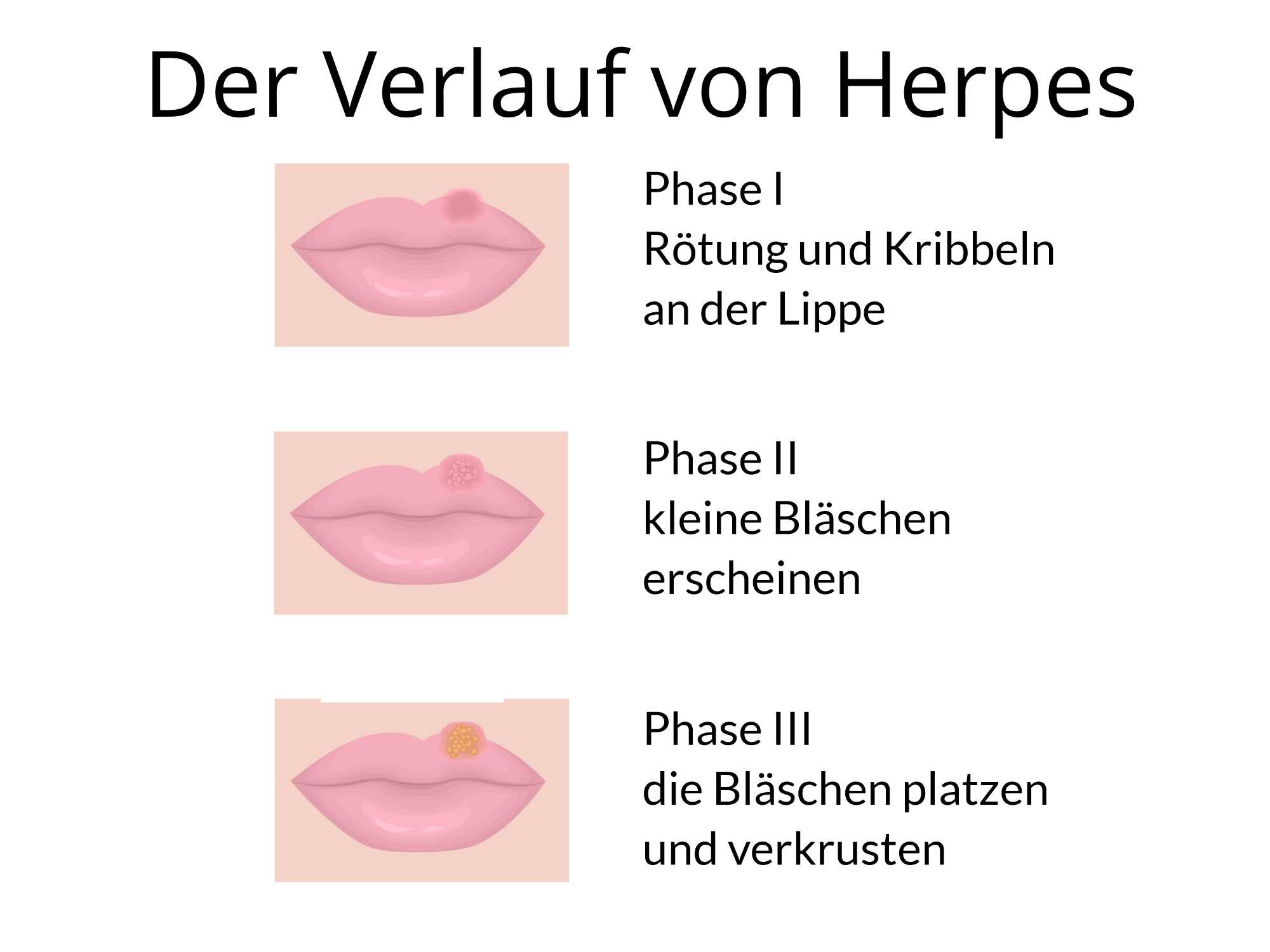 In one study published in Antimicrobial Agents and Chemotherapy, researchers found that high doses and short courses of valacyclovir may reduce the duration of a cold sore by about 1 day.
In one study published in Antimicrobial Agents and Chemotherapy, researchers found that high doses and short courses of valacyclovir may reduce the duration of a cold sore by about 1 day.
Taking medication when symptoms first appear can prevent or block the cold sore from appearing.
Stage 2
If the person does not use any medication, a fluid-filled blister will likely develop around 1 to 2 days after the initial symptoms.
Stage 3
The third stage, which occurs around day 4, involves the blister opening up and releasing its fluid. Doctors call this stage the ulcer or weeping stage. If another person comes into contact with the blister’s fluid, they may develop a cold sore as well.
Cold sores are contagious and tend to be painful during this stage.
Stage 4
Between days 5 and 8, the cold sore will dry up, leaving a yellow or brown crust. The crust will eventually flake off.
People must take care of the scab during this stage because it can crack or break.
Stage 5
The final stage of a cold sore is the healing stage.
Several scabs may form and flake off during this stage. Every new scab will be smaller and smaller until the wound heals completely. Most often, the cold sore will not leave a scar.
Some doctors suggest that a cold sore can last around 2 to 6 weeks.
People who come into contact with another person’s cold sore may be at risk of infection. However, they would have to come into contact with the fluid when the blister ruptures.
Some people may develop recurring cold sores. According to the American Family Physician (AAP), various stimuli can awaken the hibernating virus, such as:
- stress
- fever
- sun exposure
- extremes in temperature
- ultraviolet radiation
- a compromised immune system
- injury
When a cold sore enters the ulcer or weeping stage, around the fourth day, the cold sore becomes contagious.
People who come into contact with the fluid from another person’s open blister can develop a cold sore between 2 to 20 days after contact.
People can come into contact with fluid from another person’s cold sore through kissing or sharing utensils, drinkware, cosmetics, or towels.
Doctors suggest that treating a cold sore at the start of symptoms, before the blister appears, may prevent the cold sore from appearing.
People with a history of cold sores can usually detect the initial symptoms and know they need to start treatment right away.
Some people get chronic cold sores and may require preventive treatments. Taking acyclovir or valacyclovir every day may prevent cold sores.
According to the AAP, the recommended doses for each drug are:
- acyclovir 400 milligrams (mg), twice daily
- valacyclovir 500 mg, once daily
People with chronic cold sores will need to take preventive treatments regularly. Also, doctors and dentists recommend:
- eating foods high in lysine, such as red meats, fish, and dairy
- applying sunscreen to the face and lips before going outside throughout the year
- shaving with a disposable razor blade when a cold sore appears
- replacing toothbrushes
- avoiding stress
People should avoid intimate contact with people who have cold sores. Avoid sharing utensils, toothbrushes, towels, and razors.
Avoid sharing utensils, toothbrushes, towels, and razors.
People with cold sores should avoid touching the blister, and if they do, they need to wash their hands thoroughly.
Cold sores are a common infection of nongenital HSV-1 that people can contract through sexual and nonsexual activities.
People who start treatment when they feel tingling and itching around their lips may block the cold sore from appearing.
If a cold sore appears, it will go through five stages from the prodrome stage to healing. During the ulcer stage, people can transmit the virus to another person. The fluid in the blister contains the virus. People with cold sores must avoid kissing and sharing utensils, towels, and drinkware.
A person may have a cold sore for about 2 weeks, but some doctors suggest that a cold sore can last up to 6 weeks. Medications can help shorten the duration of a cold sore.
Herpes (colds on the lips)
Herpes on the lips has several names: “cold” on the lips, fever on the lips, herpes of the lips, herpes labialis, labial or labial herpes.
“Cold” on the lips, mainly caused by herpes simplex virus type I (HSV-I) . 95% of people have this virus in their body. In rare cases, the cause of herpes lips is the herpes simplex virus type 2, (transmitted through oral sex).
The herpes simplex virus, which causes a “cold” on the lips, remains inside the human body for life. At the moment, no medicines and treatments have been developed that would completely destroy the herpes simplex virus in the human body.
Up to 10,000,000 Russians annually suffer from “colds” on the lips. Approximately every 5 Russians get herpes of the lips from 2 to 10 times a year. And only about 5% of the human race has immunity to HSV-I, the reasons for which are still unclear.
The virus enters the body in early childhood: at 3-4 years old, when the antibodies against the herpes virus transmitted to the baby by the mother are depleted. Most often, infection occurs if the child is kissed by carriers of the infection. For example, parents, brothers, sisters and other relatives. In addition to a kiss, the virus can enter the body along with the biological fluids of others, for example, with saliva.
For example, parents, brothers, sisters and other relatives. In addition to a kiss, the virus can enter the body along with the biological fluids of others, for example, with saliva.
Having come to visit us, it penetrates into the mucous membranes, reaches the nerve endings. Through them, with a current of fluid that feeds the nerves, it rises into the cranial cavity, where it “hides” in the nerve plexus, called the trigeminal ganglion , and “sleeps” there until the moment of reactivation.
Reactivation of the virus is possible at the moment when immunity “decreases”. “Decrease” in immunity can occur under the influence of: colds, flu, menstruation, emotional distress and stress, strong ultraviolet radiation, excessive alcohol consumption, indigestion and fatigue.
Causes of recurrence of herpes on the lips:
– Stress or emotional disorder;
– Various somatic diseases, in particular colds, flu, diabetes, HIV;
– Poisoning or intoxication;
– Alcohol, caffeine and smoking;
– Excessive ultraviolet exposure;
– Hypothermia or overheating;
– Coming of menstruation;
– Overwork and exhaustion;
– Malnutrition/diet or indigestion;
– Other individual factors;
After “awakening” the virus is sent to the nerves (like a train on rails) from the trigeminal ganglion back to the skin. It is important to know that branches that innervate the lips, oral mucosa, gums, skin on the earlobe and part of the cheek depart from the trigeminal plexus. In accordance with the outgoing nerves, lesions on the skin will also be located. As it passes through the nerve, the virus causes inflammation of the nerve tissue, which causes pain along the course of the nerve fiber.
It is important to know that branches that innervate the lips, oral mucosa, gums, skin on the earlobe and part of the cheek depart from the trigeminal plexus. In accordance with the outgoing nerves, lesions on the skin will also be located. As it passes through the nerve, the virus causes inflammation of the nerve tissue, which causes pain along the course of the nerve fiber.
Stages of development of a “cold” on the lips
In its development, the disease goes through stages IV:
Stage I – tingling.
At this time, most people feel that they are getting sick. Before a “cold” appears, the skin at the corners of the mouth or the inside of the lips, or on the tongue, or even all over the face begins to itch.
In a place where a recurrence of herpes will soon develop, harbingers of the disease appear: pain, tingling, tingling, itching. The skin over the site of the future relapse turns red.
The development of the disease can be prevented if drugs based on acyclovir (Zovirax ointment) are used at this stage. If you suffer from severe itching, you can take an aspirin or paracetamol tablet.
Stage II – the stage of inflammation, begins with a small painful vesicle, which gradually increases in size. The bubble is tense and filled with a clear liquid, which later becomes cloudy.
Stage III – stage of ulceration. The bubble bursts, and a colorless liquid flows out of it, stuffed with billions of viral particles. In its place, an ulcer is formed.
At this point, the sick person is highly contagious, as she releases a huge amount of viral particles into the environment. Because of the soreness and sores on the face, people are most annoyed by this stage.
IV stage eschar formation. A crust forms over the sores, if damaged, pain and bleeding can occur.
Herpes rashes are most often located on the red border of the lips, but can also be on the nose, on the cheeks, in the ears, on the forehead, in the oral cavity: on the gums, the inner surface of the lips and cheeks.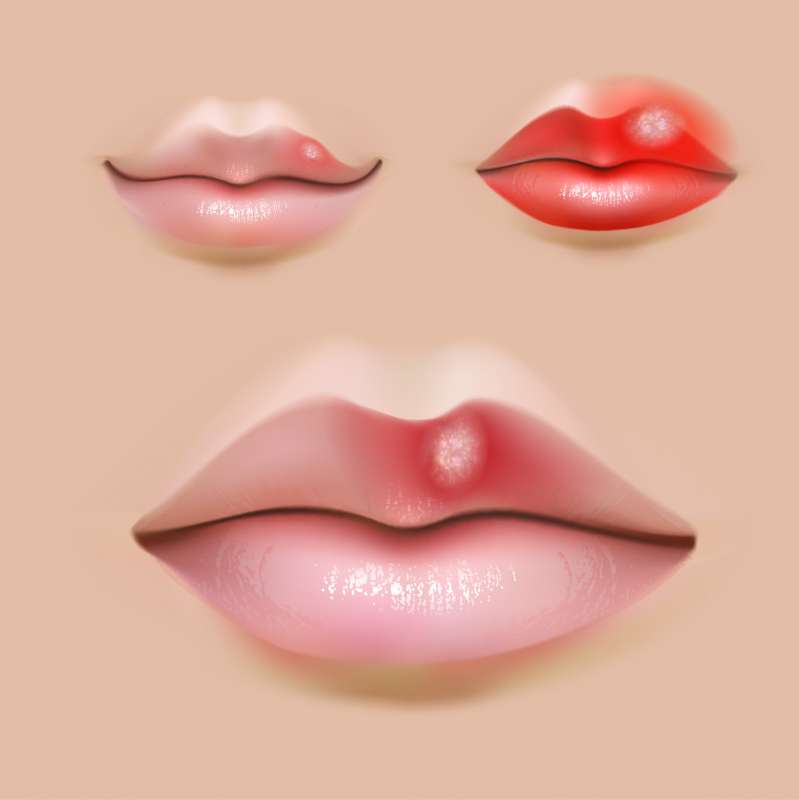
Complications of the “cold” on the lips
If personal hygiene rules are not followed, the virus can affect other parts of the body: if you rub your eyes with your hands after touching the blisters or sores, you can provoke ophthalmic herpes 9 0006 or herpes eye – severe eye damage, sometimes leading to decreased vision and even blindness. Herpetic eczema may develop – a virus infection of the skin of the fingers.
If you kiss someone with ulcerated lips, you can pass the infection to the child or loved ones.
Oral sex with a partner with an active “cold” on the lips can lead to “ genital herpes “. Those. during an outbreak of a “cold” on the lips, herpes can be mechanically transferred from the lips of an “active” sexual partner in oral sex to the genitals of the recipient of oral caresses.
This is how patient M. describes the severe course of herpetic infection on the lips: He is very worried about headaches and intoxication, as a rule, for no apparent reason, symptoms of severe poisoning appear. Tablets from the “head” help with difficulty, more or less saves an injection of analgin with diphenhydramine. Not a single doctor even wanted to talk about a headache and listen .”
Tablets from the “head” help with difficulty, more or less saves an injection of analgin with diphenhydramine. Not a single doctor even wanted to talk about a headache and listen .”
In people with reduced immunity (immunosuppression, HIV infection), necrotic forms of the course with the formation of scars on the skin are possible. 6.” Colds are contagious! Always wash your hands with soap and water before and after touching cold sores, including after applying antiviral cream.
– Don’t touch your eyes! Especially women during make-up;
– Do not use saliva to wet contact lenses.
– Despite itching and pain, do not touch rashes, kiss, especially with children, use someone else’s lipstick or borrow your own, smoke one cigarette with a friend (girlfriend).
– Do not attempt to remove blisters or crusts to avoid transmission of infection to other parts of the body or bacterial infection.
– Stop oral sex! Oral sex during a “cold” on the lips of an “active” partner can cause genital herpes in a partner who is passively participating in oral sex. In this case, herpes from the lips of the “active” partner can be transferred to the genitals of the partner receiving caresses.
– If you have a cold on your lips, use individual dishes or towels, do not drink from other people’s glasses…
Newborn care. To avoid contracting herpes in the newborn, women who have cold sores on the lips should thoroughly wash their hands before touching their baby. If there are blisters or sores on the lips, a disposable surgical mask or gauze bandage should be used while caring for the child until the sores dry out. During a cold on the lips, do not kiss or sniff the child. If there is herpes on any other part of the body, then it must be carefully closed and in no case should it come into contact with the skin of the child.
REMEMBER:
– By the time you feel the tingling, the virus has already started, which means it’s time to start using the antiviral cream or other antiviral drugs prescribed by your doctor without delay;
– Use your medicine!
Medicines can help stop a relapse or speed up recovery.
Use aciclovir creams and ointments to help heal blisters and ulcers quickly, supplements containing either zinc or L-LYSINE. Remember that the use of corticosteroids (hydrocortisone ointment) reduces itching, but dramatically increases the area and severity of the lesions and the duration of the painful period.
– Apply antiviral ointments with cosmetic sticks.
To apply antiviral ointments (Acyclovir, Zovirax) to herpetic eruptions, use special cosmetic sticks, as shown in this picture.
Applying ointments to the lesion directly with the fingers can cause the virus to be transferred from the lips to the skin of the fingers.
– If you have frequent relapses, then make sure that you always have the medicine at hand. Like a passport or money, keep it with you at all times;
– Aciclovir creams and ointments must be used at least 4 times a day for 5 days.
– Valaciclovir may be prescribed for one-day treatment of lip herpes by a physician. If you take two tablets of valaciclovir 500 mg first in the morning and then in the evening, within 24 hours from the onset of the disease, then a cold on the lips will not develop or the healing of herpetic lesions will occur faster.
If you take two tablets of valaciclovir 500 mg first in the morning and then in the evening, within 24 hours from the onset of the disease, then a cold on the lips will not develop or the healing of herpetic lesions will occur faster.
– If a “cold” does not go away within 10 days, be sure to consult a dermatologist, as a “cold” on the lips can be a symptom of other serious diseases that require specialized treatment.
– Prolonged course of a cold on the lips (more than 30 days) may be a sign of a sharp decrease in immunity, benign tumors and oncological diseases, HIV infection, lymphoproliferative diseases.
Lip herpes diagnosis | Haleon HealthPartner
Lip Herpes Cycle Information
Stage 1: Stinging
The tingling sensation that occurs before the rash appears is caused by reactivation of a dormant HSV-1 virus located in the trigeminal ganglion. 2.3
- The virus migrates to the nerve ending near the oral mucosa (lips/oral cavity) 3
- It invades cells in/near the oral mucosa 4
- Infection begins with the spread of the virus to multiple lesions from a single infected nerve 3
Stage 2: Redness/swelling
The immune system triggers an inflammatory process that leads to redness and swelling.
 5
5 Stage 3: Bubble
Without adequate treatment, there is a high probability of progression of herpes of the lips to the formation of a bubble. 3
- After 2-3 cycles of viral replication, the points of infection expand and connect, forming a clinically pronounced lesion against the background of hyperemia 3
- A collection of small, fluid-filled blisters appear, usually on the vermilion border of the lip (the line separating the lip from adjacent skin) 6
Stage 4: Ulcer
- Fluid-filled blisters burst, forming a shallow red ulcer. The excreted fluid is highly contagious. 2 Soft crust starts to form 5
- Often the most painful stage 2
Stage 5: Crusting
Ulcer dries up, forming a tougher yellow/brown crust.
 A scab is forming. 2.5
A scab is forming. 2.5 Stage 6: Healing
Dry eschar flakes off leaving residual redness and swelling. Skin re-epithelialization is complete and the virus returns to a latent state. 2.7
Symptoms and situations in which pharmacists should advise the patient to seek medical advice
5 8 | These individuals are at higher risk of developing more severe symptoms and more frequent relapses |
RASHES NOT ON THE LIPS OR SKIN SURROUNDING THE LIPS 8 | Currently available over-the-counter products are only indicated for the treatment of labial herpes and should not be recommended for rashes on other parts of the body such as the genitals, mouth, or eyes. Special care should be taken to avoid getting OTC creams in the eyes |
PEOPLE WITH SEVERE IMPAIRMENT 8 | These people should be seen by a physician to rule out other conditions and consider both OTC and prescription drugs |
PREGNANT WOMEN 9 | The risk of infection in newborns by kissing is highest when a woman first becomes infected (cold sores) in the third trimester, and especially during 6 weeks after birth, since shedding of the virus into the saliva may continue, and the baby is likely to be born before the development of protective maternal antibodies |
INFANT 10 | Because newborns have an underdeveloped immune system, they can quickly become seriously ill after being infected with the HSV-1 virus and may need intravenous antiviral therapy. |

 5
5 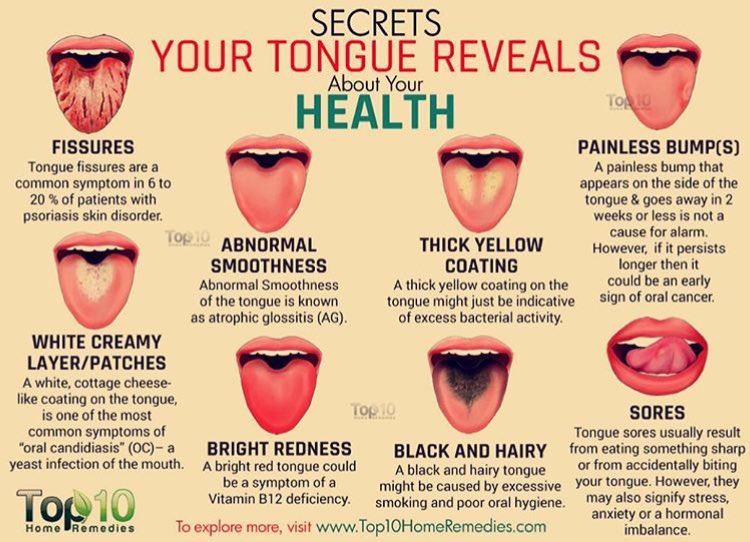 A scab is forming. 2.5
A scab is forming. 2.5 